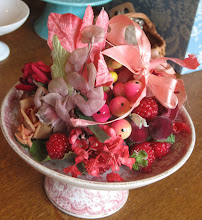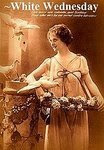Growing up the daughter of an antique dealer, I had lots of early exposure to auctions, shows, shops, and the gamut. Among Mom's specialties were American art pottery and ceramics in general. At one point, she had a yellow spatterware plate with a blue dahlia painted in the center. She was asking $300 for it. $300! was shocking to me in the 1970s. As a teenager then, $300 for one plate seemed incredible. I loved it, but....
I don't have a picture of Mom's plate (long since sold to some grateful buyer), but I can show you the legacy (some non-spatter items are on the bottom):
 About 10 years ago I started collecting spatterware when I could find it for reasonable prices. Mom gave me her books Spatterware and Sponge by the Robackers (out of print and $$$ when you can find it) and Homespun Ceramics by the Greasers (OOP also, I think). Yellow is the rarest, which explains the high price of Mom's plate way back when. Today, that plate would be in the thousands.
About 10 years ago I started collecting spatterware when I could find it for reasonable prices. Mom gave me her books Spatterware and Sponge by the Robackers (out of print and $$$ when you can find it) and Homespun Ceramics by the Greasers (OOP also, I think). Yellow is the rarest, which explains the high price of Mom's plate way back when. Today, that plate would be in the thousands.Among collectors of Americana, spatterware is a favored ceramic choice, even though it was primarily made in England in the early 19th century (really popular about 1830s-1850s). It was very popular and some think that the bright colors and patterns were especially liked by the Pennsylvania Germans. The paint forming the spatter design is thought to have been applied with a sponge or fine-woven cloth to achieve the spatter effect. If the paint was applied only to the rim of the plate or saucer, often a handpainted design was put in the center. These designs usually have a very folky quality. Sometimes, transfers were applied, like the example at the far left on my top shelf. I found that last summer at Upstairs Antiques in Concord, Massachusetts, for a great price! And I didn't expect to come across any spatterware while in New England. You never know.
Rainbow spatter is a piece that has a striped multi-color spatter pattern. There are two pieces on the middle shelf of my hutch. Both have flaws--but I love them! Important to note: condition is a huge factor in price for spatterware, just as with most other antiques. Rarity is another. I've already mentioned yellow is rare; blue, heavily represented in my collection, is the most common. Spatterware has also been reproduced, so beware when shopping for the real thing.
As anyone who collects anything knows, the search is at least half the fun. Do you find any spatterware where you live?





































5 comments:
Hi Jenny, thanks for coming by. I love this post about the spatterware. I don't know a lot when it comes to specifics on antiques, only what I like or don't like. The pieces you have in your hutch are beautiful. Thanks so much for the background on spatterware, now I know something to look for.
Debra
Hey Jenny,
Silly me, left a comment for you, on my comment page...WAY TOO MUCH STRESS!
Barb C.
{I'll be getting better images for you Tuesday!}
What a beautiful collection!
I don't know that much about splatterware. I do have some newer pieces that I have put away...blue mostly.
Yes I have a problem with deciding on style. Though lately I have been much better. It's hard when there's such beautiful things out there.
Very nice collection of pottery, your mother is proud i'm sure.
cindy-stitches-n-stuff.blogspot.com
Post a Comment